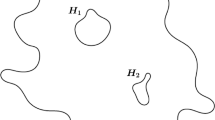Abstract
In this article, a complete visual hull model is introduced. The proposed model is based on bounding edge representation which is one of the fastest visual hull models. However, the bounding edge model has fundamental drawbacks, which make it inapplicable in some environments. The proposed model produces a refined result which represents a complete triangular mesh surface of the visual hull. Further, comparison of the results by the state-of-the-art methods shows that the proposed model is faster than most of modern approaches, while the results are qualitatively as precise as theirs. Of interest is that proposed model can be computed in parallel distributively over the camera networks, while there is no bandwidth penalty for the network. Consequently, the execution time is decreased by the number of the camera nodes dramatically.
Access this chapter
Tax calculation will be finalised at checkout
Purchases are for personal use only
Preview
Unable to display preview. Download preview PDF.
Similar content being viewed by others
References
Cheung, K.M., Baker, S., Kanade, T.: Shape-From-Silhouette Across Time Part II: Applications to Human Modeling and Markerless Motion Tracking. International Journal of Computer Vision 63(3), 225–245 (2005)
Martin, W.N., Aggarwal., J.K.: Volumetric Description of Objects from Multiple Views. IEEE Transaction on Pattern Analysis and Machine Intelligence (PAMI) 5(2), 150–158 (1983)
Baumgart, B.G.: A Polyhedron Representation for Computer Vision. In: AFIPS National Computer Conference (1975)
Laurentini, A.: The Visual Hull: A New Tool for Contour-based Image Understanding. In: 7th Scandinavian Conference on Image Analysis, pp. 993–1002 (1991)
Jackins, C.L., Tanimoto, S.L.: Oct-trees and Their Use in Representing Three-dimensional Objects. Computer Graphics and Image Processing 14, 249–270 (1980)
Lazebnik, S., Boyer, E., Ponce, J.: On Computing Exact Visual Hulls of Solids Bounded by Smooth Surfaces. In: CVPR 2001 (December 2001)
Buehler, C., Matusik, W., McMillan, L.: Polyhedral Visual Hulls for Real-time Rendering. In: Eurographics Workshop on Rendering (2001)
Franco, J.-S., Boyer, E.: Exact Polyhedral Visual Hulls. In: Fourteenth British Machine Vision Conference (BMVC), Norwich, UK, pp. 329–338 (September 2003)
Buehler, C., Matusik, W., McMillan, L., Gortler, S.: Creating and Rendering Image-based Visual Hulls. Technical Report. MIT-LCS-TR-780. MIT (1999)
Matusik, W., Buehler, C., Raskar, R., Gortler, S.J., McMillan, L.: Image-based Visual Hulls. In: SIGGRAPH 2000 (July 2000)
Cheung, G.: Visual Hull Construction, Alignment and Refinement for Human Kinematic Modeling, Motion Tracking and Rendering. Doctoral dissertation, Technical Report CMU-RI-TR-03-44, Robotics Institute, Carnegie Mellon University (October 2003)
Cheung, G., Baker, S., Kanade, T.: Visual Hull Alignment and Refinement Across Time: a 3D Reconstruction Algorithm Combining Shape-Frame-Silhouette with Stereo. In: CVPR 2003, Madison, MI (2003)
Lazebnik, S., Furukawa, Y., Ponce, J.: Projective Visual Hulls. International Journal of Computer Vision 74(2), 137–165 (2007)
Cheung, K., Baker, S., Kanade, T.: Shape-From-Silhouette Across Time Part I: Theory and Algorithms. International Journal on Computer Vision 62(3), 221–247 (2005)
3D Photography Dataset. Beckman Institute and Department of Computer Science, University of Illinois at Urbana-Champaign, http://www-cvr.ai.uiuc.edu/ponce_grp/data/mview/
Middlebury Multi-View Datasets. Middlebury College, Microsoft Research, and the National Science Foundation, http://vision.middlebury.edu/mview/
Intel’s OpenCV library written in C programming language, http://sourceforge.net/projects/opencvlibrary/
Author information
Authors and Affiliations
Editor information
Editors and Affiliations
Rights and permissions
Copyright information
© 2010 Springer-Verlag Berlin Heidelberg
About this paper
Cite this paper
Raeesi N., M.R., Wu, Q.M.J. (2010). A Complete Visual Hull Representation Using Bounding Edges. In: Qiu, G., Lam, K.M., Kiya, H., Xue, XY., Kuo, CC.J., Lew, M.S. (eds) Advances in Multimedia Information Processing - PCM 2010. PCM 2010. Lecture Notes in Computer Science, vol 6297. Springer, Berlin, Heidelberg. https://doi.org/10.1007/978-3-642-15702-8_16
Download citation
DOI: https://doi.org/10.1007/978-3-642-15702-8_16
Publisher Name: Springer, Berlin, Heidelberg
Print ISBN: 978-3-642-15701-1
Online ISBN: 978-3-642-15702-8
eBook Packages: Computer ScienceComputer Science (R0)




